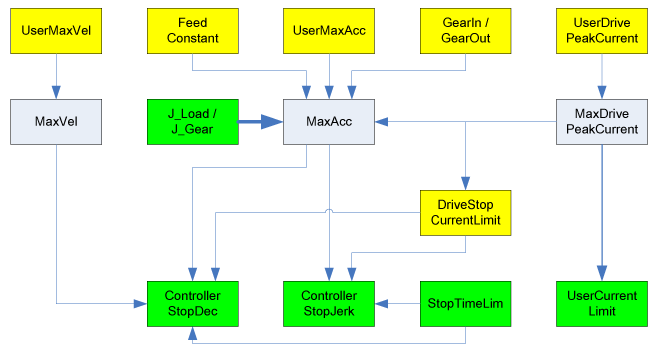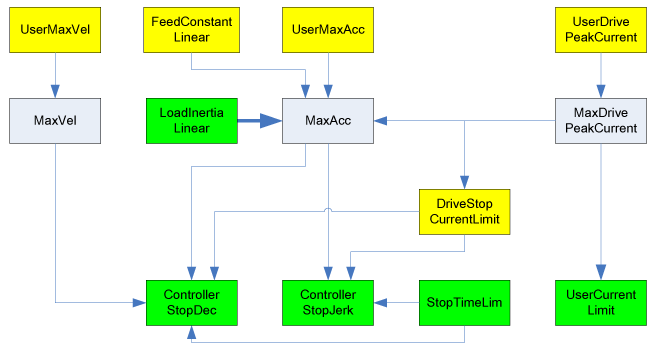|
Type |
EF |
|
Offline editable |
Yes |
|
Devices supporting the parameter |
Lexium LXM52 Drive, Lexium LXM52 Linear Drive, Lexium LXM62 Drive, Lexium LXM62 Linear Drive, Lexium ILM62 Drive Module, Sercos Drive |
|
Traceable |
Yes |
ControllerStopDec contains the maximum absolute value of the deceleration in units/s2 with which the drive is stopped. This value is effective with ControllerStop and with the drive reaction BD2 (User defined stop).
The parameter can be modified offline and online.
The default value for this parameter is 0 to add compatibility to the previous behavior of ControllerStop.
Zero (0) has a special meaning which does not correspond to the usual progress in the value range. Zero (0) means that the maximum possible acceleration (MaxAcc) has been parameterized. A modification of MaxAcc is applied under the following conditions:
oSercos phase up
oChanging the parameter ControllerStopDec
The minimal acceleration is defined as follows:
MinDec = MaxVel [units/s] / (StopTimeLim [ms] * 0.001 [s/ms])
If you specify a value exceeding MaxAcc here, ControllerStopDec is limited to MaxAcc. If you specify a value smaller than MinDec, ControllerStopDec is limited to MinDec.
NOTE: Before entering ControllerStopDec, verify the parameters MaxVel, MaxAcc, and StopTimeLim. Changing these parameters at a later stage does not influence ControllerStopDec.
|
NOTICE |
|
MECHANICAL COLLISION OF MACHINE PARTS |
|
When reducing ControllerStopDec the time and the necessary position range for a stop increases. This is why the value for ControllerStopDec has to be set such so that there is enough position range for a collision-free stop. |
|
Failure to follow these instructions can result in equipment damage. |
NOTE: The parameters ControllerStopDec, ControllerStopJerk, and ControllerStopSet are supported as of V1.35.1.5 from the Sercos Drive. As of this version the Sercos Drive also implements the interface IF_ControllerStop.
During the user-defined stop, a reference value profile, which is defined via the ControllerStopDec and ControllerStopJerk parameter, is started to stop the drive. The start values of the profile correspond with the values of the position, the speed and, if applicable, the acceleration. The profile is generated in the drive and can also be processed in case of a detected Sercos error. This function is enabled if
oControllerEnable is switched off and ControllerEnableStopMode is set to "UserDefinedStop / 0" (default value) or
oa diagnostic message is triggered with reaction BD2.
NOTE: The parameterization for devices of the type Sercos Drive is not performed automatically. A parameterization must be performed manufacturer-specific if it is supported by the respective Sercos Drive.
NOTE: The ControllerStopDec parameter must not be modified as long as the user-defined stop is being executed.
Difference Between ControllerStop and User-Defined Stop
Compared to the user-defined stop, you can access the reference values of the drive (reference position and reference acceleration) with ControllerStop. The profile for stopping the drive is the same if the UserDefinedStopMode parameter is set to Start with reference values. By default the UserDefinedStopMode parameter is set to Start with actual values. The user-defined stop in the drive is parameterized in the PacController like the ControllerStop function using the ControllerStopDec and ControllerStopJerk parameter.
NOTE: Since the device Sercos Drive does not support the parameter StopTimeLim, the maximum value of StopTimeLim is assumed for the calculation formula above. This value is 10000 ms.
NOTE: The parameter value is transferred from the master to the slave via the parameter channel of the Sercos at every access. Typically, this takes about 10 ms. However, times up to 1 s can occur if there is a lot of data transferred on the parameter channel.
The following graphic shows the dependency with other object parameters for rotary drives:

The following graphic shows the dependency with other object parameters for linear drives:

Yellow parameters are input parameters, whose values are taken over by the Sercos phase up. Green parameters are input parameters, whose values are taken over immediately. Gray parameters are output parameters. Thick arrows show that a parameter makes an impact on another parameter immediately by the input. Thin arrows show that a parameter does not have an impact until the next Sercos phase up or when the dependent parameter is entered. The arrow indicates the effective direction of the dependency.
Example:
Entering J_Load has a direct impact on the parameter MaxAcc. A revision of MaxAcc only has an impact on ControllerStopDec if,
oa Sercos phase up takes place or
othe parameter ControllerStopDec is modified.